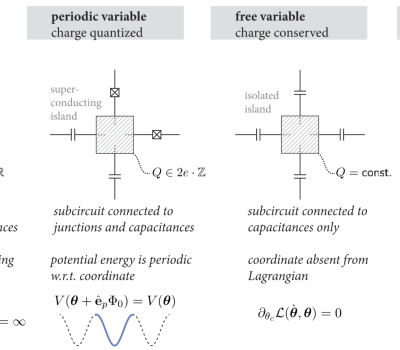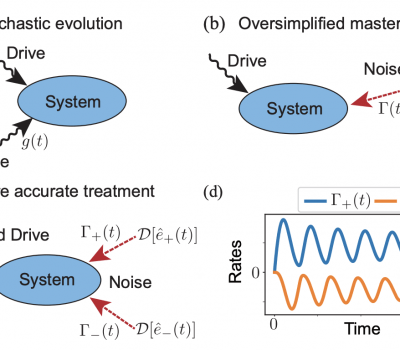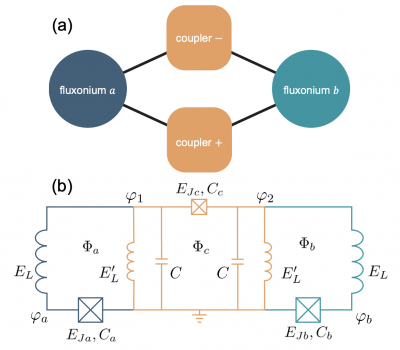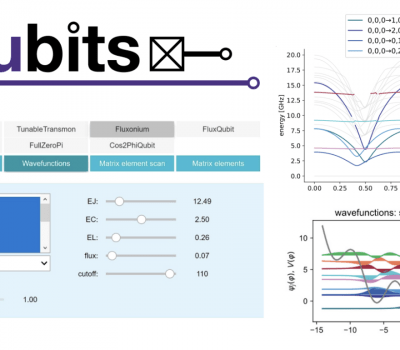We present a formalism to quantize a general superconducting circuit with Josephson junctions. The formalism is amenable to an algorithmic implementation and we present an extension Circuit to the scqubits package which deals with a generic superconducting circuit. This algorithm is able to identify all the degrees of freedom and their boundary conditions. Moreover, the non dynamical […]
Uncategorized
New arXiv preprint: Simple master equations for describing driven systems subject to classical non-Markovian noise
Together with theory collaborators from UChicago we analyze driven quantum systems subject to non-Markovian noise. These systems are typically difficult to model even if the noise is classical. We present a systematic method based on generalized cumulant expansions for deriving a time-local master equation for such systems. This master equation has an intuitive form that […]
New arXiv preprint: Fast high-fidelity gates for galvanically-coupled fluxonium qubits using strong flux modulation
Along with coworkers from the Schuster lab at UChicago, we introduce a coupling scheme for low frequency fluxonium qubits that allows for high-fidelity entangling gates. Long coherence times, large anharmonicity and robust charge-noise insensitivity render fluxonium qubits an interesting alternative to transmons. Recent experiments have demonstrated record coherence times for low-frequency fluxonia. Here, we propose […]
New arXiv preprint: Computer-aided quantization and numerical analysis of superconducting circuits
The development of new superconducting circuits and the improvement of existing ones rely on the accurate modeling of spectral properties which are key to achieving the needed advances in qubit performance. Systematic circuit analysis at the lumped-element level, starting from a circuit network and culminating in a Hamiltonian appropriately describing the quantum properties of the […]
Open-access publication in Quantum: Scqubits: a Python package for superconducting qubits
scqubits is an open-source Python package for simulating and analyzing superconducting circuits. It provides convenient routines to obtain energy spectra of common superconducting qubits, such as the transmon, fluxonium, flux, cos(2ϕ) and the 0-π qubit. scqubits also features a number of options for visualizing the computed spectral data, including plots of energy levels as a function of external parameters, […]
New PRX Quantum Perspective: Moving beyond the Transmon: Noise-Protected Superconducting Quantum Circuits
Artificial atoms realized by superconducting circuits offer unique opportunities to store and process quantum information with high fidelity. Among them, implementations of circuits that harness intrinsic noise protection have been rapidly developed in recent years. These noise-protected devices constitute a new class of qubits in which the computational states are largely decoupled from local noise […]
New Phys. Rev. Research Publication: Variational tight-binding method for simulating large superconducting circuits
With our collaborators David Ferguson and Wade DeGottardi of Northrop Grumman Corporation, we have just published in the open-access journal PRResearch a new technique for simulating large superconducting circuits. In this paper we generalize solid-state tight-binding techniques for the spectral analysis of large superconducting circuits. We find that tight-binding states can be better suited for […]
Introducing scqubits: a Python package for superconducting circuits
scqubits is an open-source Python package for simulating and analyzing superconducting circuits. It provides convenient routines to obtain energy spectra of common superconducting qubits, such as the transmon, fluxonium, flux, cos(2φ) and the 0-π qubit. scqubits also features a number of options for visualizing the computed spectral data, including plots of energy levels as a […]
New arXiv preprint: Moving beyond the transmon: Noise-protected superconducting quantum circuits
Artificial atoms realized by superconducting circuits offer unique opportunities to store and process quantum information with high fidelity. Among them, implementations of circuits that harness intrinsic noise protection have been rapidly developed in recent years. These noise-protected devices constitute a new class of qubits in which the computational states are largely decoupled from local noise […]
New arXiv preprint: Variational tight-binding method for simulating large superconducting circuits
We generalize solid-state tight-binding techniques for the spectral analysis of large superconducting circuits. We find that tight-binding states can be better suited for approximating the low-energy excitations than charge- basis states, as illustrated for the interesting example of the current-mirror circuit. The use of tight binding can dramatically lower the Hilbert space dimension required for […]







